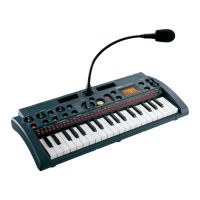42
MIDI guide
MIDI stands for Musical Instrument Digital Interface, and is a world-wide
standard for exchanging performance-related data between electronic musi-
cal instruments and computers.
When a MIDI device is connected to another MIDI device (or computer) via
MIDI cables (or USB), the devices can exchange performance data even if
they were made by different manufacturers.
The microSAMPLER’s pattern sequencer and effect delay time can synchro-
nize to MIDI clock data from an external MIDI sequencer.
The “MIDI Implementation” including details on the MIDI exclusive format
can be downloaded from the Korg website.
1. Connecting a MIDI device or computer
Controlling an external MIDI sound module from the microSAM-
PLER
If you want to use the microSAMPLER’s keyboard, controllers, and pattern
sequencer to play or control an external MIDI sound module, use a MIDI
cable to connect the microSAMPLER’s MIDI OUT connector to your external
MIDI sound module’s MIDI IN connector.
Controlling the microSAMPLER from an external MIDI device
If you want to use another MIDI keyboard or sequencer to play or control
the microSAMPLER’s sound generator, use a MIDI cable to connect your
external MIDI device’s MIDI OUT connector to the microSAMPLER’s MIDI
IN connector.
Connecting the microSAMPLER to a computer via USB
You can use a USB cable to connect the microSAMPLER directly to a com-
puter that has a USB connector.
If you’re using the editor/librarian software, you’ll need to use the faster
USB connection since a large amount of data will be transmitted and
received.
In order to use a USB connection, the Korg USB-MIDI driver must be installed
on your computer. Download the Korg USB-MIDI driver from the Korg web-
site, and install it as directed by the accompanying documentation.
If either the MIDI connection or USB connection does not work correctly,
check the “GLOBAL” page MIDI.ROUT setting (☞p.39 “MIDI.ROUT (MIDI Rout-
ing)”).
Using the microSAMPLER with other
MIDI devices
MIDI OUT MIDI IN
EM-1
TAP
1 2
5
7
10 12
14
16
15131198
4
3
microSAMPLER
MIDI sound
module
MIDI IN MIDI OUT
microSAMPLER
MIDI keyboard
microSAMPLER
Computer
USB cable

